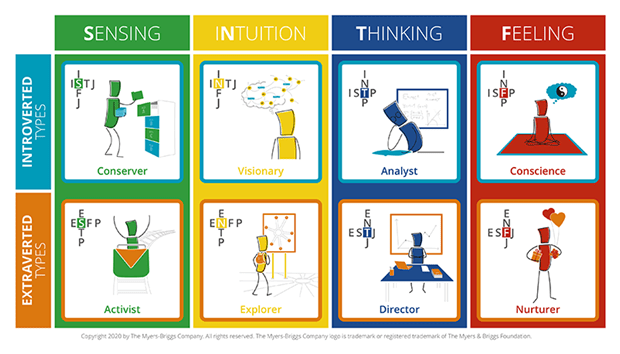Myers Briggs Type Indicator MBTI®
The Myers-Briggs indicator, MBTI® is a self-reported questionnaire that assesses how well people perceive the environment and make decisions. It was created by Katharine Cook Briggs and her daughter Isabel Briggs Myers during World War II, and the criteria used are based on the proposals that Carl Gustav Jung published in his work Psychological Types.
What is the personality type?
Jung developed his ideas about personality type in an effort to explain the normal and natural differences between healthy people.
Based on his observations, Jung concluded that differences in attitudes and behavior result from the natural tendencies that people have to use their minds in different ways. As people act on their natural tendencies, they develop corresponding behavior patterns that they find satisfying. Jung‘s theory of personality types defines eight different patterns of behavior, which he called types, and provided a detailed description of how they develop.
Jung's image of personality
Jung observed that when people’s minds are active, they are involved in one of two basic and opposite mental processes:
Perceive: capture or collect information
Judge: reach conclusions and make decisions about what they have perceived.
The two opposite ways of taking in information are called Feeling and Intuition. The opposite ways of reaching conclusions and making decisions are called Thinking and Feeling.
Jung also saw that people tend to focus their attention and become more energized by interacting with the external world of people, things, and activities, or more by reflecting on the internal world of ideas, thoughts and observations. He called these two energy orientations Extraversion and Introversion.
While each of the four mental processes (perceiving, intuition, thinking, and feeling) has its own predictable characteristics, each also takes on a different character depending on whether the process is focuses more on the extraverted outer world or the introverted inner world.
The 16 types of Myers-Briggs do not define personality as 16 static boxes. Rather, they describe a dynamic energy system of interactive personality preferences that are expressed as pairs of opposites. Everyone tends to prefer one of each pair of opposites over the other.
Your Myers-Briggs personality type represents your natural preferences in the four aspects of personality described above, which explain the differences > natural between people. There is nothing right or wrong with these preferences. Each identifies normal and valuable human behaviors.
E EXTRAVERSION or I INTROVERSION
Opposite ways of directing and receiving energy.
SENSING or NINTUITION
Opposite ways of assimilating information
T THINKING or F FEELING
Opposite ways of deciding and drawing conclusions.
J JUDGING or P PERCEIVING
Opposite ways of approaching the outside world
While the names of some of the MBTI preferences are household words, their MBTI meaning it is something different from its everyday meaning.
Note: Extraversion does not mean talkative or loud; Introversion does not mean shy or inhibited; Feeling does not mean being emotional; Judging does not mean judging; Perceiving does not mean perceptive.
The Myers-Briggs indicator, MBTI® uses four scales, called dichotomies, defined as opposite pairs among eight categories: I introversion – E extraversion, S sensation – N intuition, T thought – F feeling, J judgment – P perception.
Each category is symbolized by a letter, so that the result is shown with a combination of four letters, among the sixteen possible ones, which is intended to define the < strong>personality of the subject.
After decades of research, MBTI® is the world’s most widely used tool for understanding personality differences among people globally.
Its application is wide:
- Self-knowledge and personal development
- Team building
- Management and leadership training
- Coaching
- Organizational development
- Training in diversity and multiculturalism
- Troubleshooting
- Professional development and exploration
- Academic advising
- Education and curriculum development
- Relationship Counseling
Myers-Briggs Type Indicator (MBTI®)

